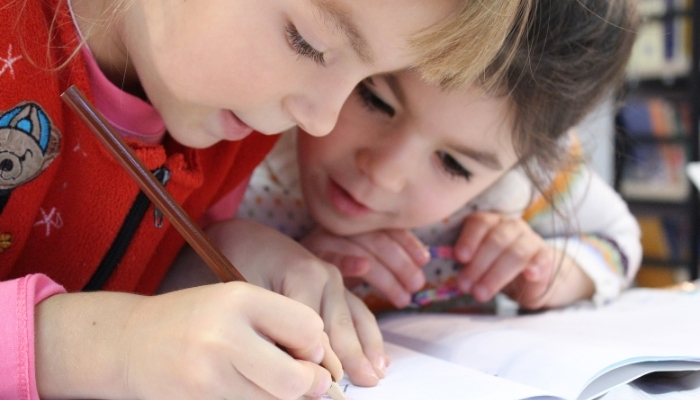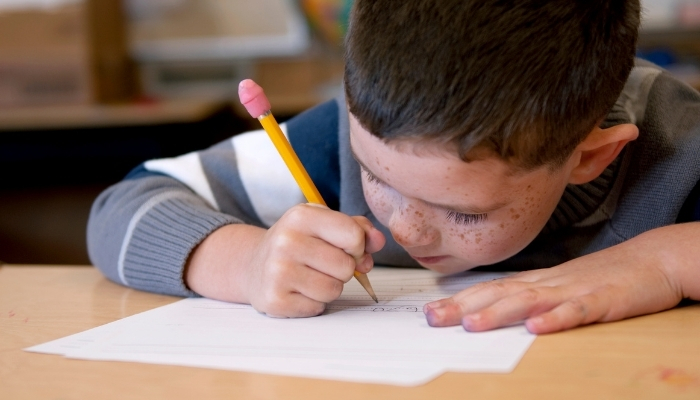Many children find writing harder than reading. They can tell stories aloud with ease but freeze when it’s time to put words on paper. Teaching writing, then, is about more than spelling or neat handwriting; it’s about helping them organise thoughts, make choices, and see language as a way to express themselves.
Research-based programs to teach kids to write make that process far less mysterious. They show children how to plan, write, and refine their ideas step by step, while giving them space to enjoy it. Over time, this structure becomes freedom, the kind that lets young writers find their voice, not just their words.
In this blog, we’ll look at how writing develops, explore the most effective programs designed to teach kids to write, and share ways parents and educators can nurture stronger, more confident young writers.
Key Takeaways
-
Children struggle with writing not because they lack ideas, but because they lack structured processes to turn thoughts into organised text.
-
The most effective programs to teach kids to write are built on explicit strategy teaching rather than generic prompts — writing skills must be modelled, not assumed.
-
SRSD, 6+1 Traits, Writer’s Workshop, handwriting foundations, and digital tools each develop different cognitive layers of writing, which is why no single program is “the magic solution.”
-
Early fluency in handwriting reduces mental load, freeing children to think about meaning, structure, and voice, not letter formation.
-
Parents should look for programs that blend structure, feedback, reflection, and engagement, because writing confidence is learned through process, not performance.
How Kids Learn to Write: The Foundation Before the Programs

Writing grows in layers. Long before children can compose a paragraph, they’re already practising the early skills that make writing possible: listening, observing, and finding patterns in language. Each stage builds on the one before it, moving from simple mark-making to thoughtful communication.
1. Building the Basics Early (Ages 3–6)
At this stage, children learn how written language works. Scribbling, drawing, and copying letters develop hand strength and coordination. Recognising letters and sounds connects spoken language to print, while playful writing like labelling drawings or writing pretend lists helps them understand that marks carry meaning.
2. Moving from Sentences to Ideas (Ages 7–9)
Once handwriting feels natural, children begin combining words and sentences to express complete thoughts. They learn how to expand sentences, choose stronger vocabulary words, and sequence ideas logically. Mistakes are part of the process; revising and rewriting teach that good writing is built through improvement, not perfection.
3. Developing Structure and Voice (Ages 10–12)
Older children start to think like writers. They plan before writing, organise ideas into paragraphs, and learn to use structure, introductions, supporting details, and conclusions to communicate clearly. Voice begins to emerge as they take ownership of their writing, making choices about tone, style, and purpose.
Understanding What Makes a Writing Program Effective

The best programs teach writing as a process, not a one-time task. They help children move through planning, drafting, revising, and reflecting, while giving them the structure and language to know what “good writing” looks like.
Effective programs share a few key elements:
-
Explicit instruction: Children are shown how to plan and organise ideas before writing, rather than being asked to “just start.”
-
Scaffolding: Each stage of writing is modelled, practised, and then gradually handed over to the child as confidence builds.
-
Feedback and reflection: Instead of grading final pieces, teachers and parents guide children to identify strengths and next steps, helping them see writing as growth over time.
-
Purpose and audience: Children write better when they know who they’re writing for, whether it’s a class story, a letter, or a creative journal.
-
Balance between structure and freedom: Too much correction can stifle creativity, while too little guidance can cause frustration. Strong programs strike a balance, giving children both direction and choice.
Top 5 Best Programs to Teach Kids Writing Skills
There are several evidence-backed programs that offer a clear structure, teaching strategy, and support for young writers. Each one approaches writing differently, but they all help children develop confidence, clarity, and purpose in their work.
Below are five of the most effective programs educators can draw from to build strong writing habits.
1. Self-Regulated Strategy Development (SRSD)
SRSD is built on the idea that writing improves when children learn both the strategy for writing and the self-management skills to use that strategy independently. It’s a structured, research-driven model proven effective across age groups because it teaches students to think like writers: planning, drafting, revising, and reflecting with intention rather than impulse.
Key elements of SRSD
-
Introduces memorable mnemonics such as POW, TREE, or TIDE to help children remember the writing sequence. For example, POW (Pick ideas, Organise notes, Write) and TREE (Topic sentence, Reasons, Explain, Ending) guide opinion or persuasive pieces; TIDE (Topic, Important details, Details, Ending) supports narrative or informational writing.
-
Encourages teacher modelling through think-alouds, where children observe how ideas move from plan to paper.
-
Builds self-regulation habits by setting goals, using positive self-talk, monitoring progress, and evaluating outcomes.
-
Works across writing types like stories, essays, and reports because it focuses on transferable thinking processes rather than memorising formats.
-
Promotes reflection after writing so students can recognise what worked and what needs to change, turning writing into a self-guided cycle rather than a one-time task.
2. 6+1 Trait Writing
6+1 Trait Writing gives children a simple, shared language to talk about writing. Instead of vague praise like “good job,” it helps them understand why a piece of writing works. The framework breaks writing into seven key traits: ideas, organisation, voice, word choice, sentence fluency, conventions, and presentation. Each trait focuses on a distinct aspect of writing, giving teachers and parents clear points to discuss and children clear goals to work toward.
Key Elements of 6+1 Trait Writing
-
Encourages focused feedback by addressing one or two traits at a time, helping children concentrate on specific improvements rather than feeling overwhelmed.
-
Builds self-assessment skills, as students learn to identify which trait they handled well and which needs work.
-
Promotes consistent language between teachers, parents, and learners, so feedback feels familiar and constructive.
-
Helps children develop a stronger sense of voice by recognising that writing reflects personality and choice, not just correctness.
-
Connects naturally with reading, since analysing author style through traits sharpens comprehension and idea development.
3. Writer’s Workshop Approach
The Writer’s Workshop approach treats writing as a craft that grows through time, reflection, and audience. It’s built around short lessons, sustained writing time, and opportunities to share work, mirroring how real writers work. Instead of prescribing rigid formats, this model nurtures voice, choice, and confidence by letting children write about topics that matter to them while still following structured guidance.
Key elements of the Writer’s Workshop
-
Begins with a mini-lesson that focuses on one clear concept—like using dialogue or creating strong openings, followed by independent writing time to apply it.
-
Encourages student choice so children write from their experiences, building ownership and authenticity in their writing.
-
Includes teacher conferences where feedback is personal, immediate, and focused on one growth point rather than multiple corrections.
-
Ends with a sharing or reflection session that builds community, as children read aloud and learn from each other’s styles and ideas.
-
Builds writing stamina and resilience by emphasising process over perfection, planning, revising, and celebrating each stage of improvement.
4. Handwriting Without Tears / Early Writing Foundations
Before children can express ideas fluently, they need the physical and cognitive control to write comfortably. Early writing programs like Handwriting Without Tears focus on building fine-motor strength, spatial awareness, and letter formation fluency, skills that make writing feel natural rather than tiring.
When handwriting becomes automatic, children can focus more on what they want to say instead of how to form each word.
Also Read: Simple Tips to Help Your Child Improve Handwriting Skills
Key elements of early writing foundations
-
Emphasises multi-sensory learning through tracing, shaping, and writing letters using materials like chalkboards, wooden pieces, or sand trays to strengthen motor memory.
-
Focuses on correct letter formation and grip, which directly affects speed and legibility as children begin composing sentences.
-
Builds core muscle coordination and posture, essential for comfortable, sustained writing sessions.
-
Reinforces letter recognition and sound-symbol association, laying the groundwork for spelling and word fluency.
-
Encourages short, frequent practice sessions, 5 - 10 minutes daily, to build endurance without fatigue or frustration.
5. Digital and Online Writing Tools for Kids
Digital tools are an integral part of the writing process. While traditional pen and paper are irreplaceable for developing fine motor skills, digital platforms can offer a new layer of engagement, instant feedback, and creativity. Tools like story-building apps, interactive writing software, and online word processors provide children with the opportunity to compose, edit, and share their writing in dynamic, tech-driven environments.
Key elements of digital writing tools
-
Interactive story-building apps that guide children through the writing process, offering prompts, sentence starters, and structure templates.
-
Online word processors with integrated spell-check and grammar suggestions that help children revise their drafts independently.
-
Writing games and activities that combine learning with fun, reinforcing sentence structure, vocabulary, and punctuation.
-
Collaborative tools where children can write together, sharing drafts, editing, and providing feedback in real-time, mimicking a writer’s workshop environment.
-
Customisable tools for engagement, where children can select avatars, themes, and storylines that suit their interests, making it feel like a creative writing journey.
What to Look for in Programs to Teach Kids to Write?

Choosing the right writing program for your child can feel overwhelming, especially with so many options available. The key is to look for programs that offer clear structure, proven methods, and the flexibility to grow with your child’s skills. Here is what you should look for in programs that teach kids to write.
-
Clear, structured frameworks: A program that teaches children a step-by-step approach to writing, from planning and drafting to revising and sharing.
-
Focus on both skills and creativity: A well-rounded program balances grammar, punctuation, and structure with creative expression and choice.
-
Self-regulation and reflection: Look for programs that teach children how to set goals, monitor their progress, and reflect on their growth.
-
Age-appropriate learning goals: Programs should cater to different developmental stages, whether it's building early writing habits or writing techniques.
-
Feedback-driven approach: A good writing program provides regular, constructive feedback on what’s working and what needs improvement.
-
Engagement and motivation: Programs that incorporate interactive elements, such as games or opportunities to share work, keep children motivated and engaged in their writing journey.
How FunFox Supports Young Writers

At FunFox, writing growth is nurtured through consistent practice, guided learning, and supportive environments where children feel encouraged to express themselves. Children learn best when they feel seen, supported, and gently stretched, and FunFox delivers that through small groups, clear routines, and meaningful teacher interaction.
-
Writers Club that helps children practise regular writing, build writing stamina, and grow comfortable sharing their ideas.
-
Readers Club that supports comprehension, vocabulary, and language development, which naturally strengthens writing over time.
-
Personalised small-group sessions led by experienced Australian teachers who adapt instruction to each child’s learning pace and comfort level.
-
Engaging activities that bring language to life through storytelling, reading experiences, creative tasks, and meaningful discussions.
-
A warm, child-centred learning culture that values confidence, curiosity, and gradual improvement rather than performance pressure.
Conclusion
Writing becomes meaningful when children have both structure and support. Each of the programs explored in this blog gives young writers a different pathway into clarity, confidence, and purpose. Some help children plan and organise their thinking.
Others refine fluency, voice, or technique. When these approaches are paired with patient guidance and steady practice, writing shifts from something they reluctantly attempt to something they genuinely feel equipped to do. Over time, children grow from placing words on a page to shaping ideas with intention.
FunFox supports this growth by offering small group classes led by Australian-qualified teachers who understand how children learn best. Book a free trial today and give your child the space, support, and encouragement they need to become a confident young writer.
FAQs
1. What are the 3 C's of writing?
The 3 C’s typically refer to being Clear, Concise, and Coherent. These qualities help a child express ideas smoothly, without unnecessary detail or confusion in their sentences.
2. What are the five writing strategies?
Five commonly taught strategies include planning ideas before writing, drafting freely, revising for clarity, editing for correctness, and reflecting on what improved from one piece to the next.
3. What's the best pre-writing activity?
Graphic organisers are one of the strongest pre-writing supports because they help children organise ideas visually before starting sentences. They reduce overwhelm and guide more structured writing.
4. How to improve elementary writing skills?
Short, consistent practice works best. Focus on sentence building, reading rich texts, adding new vocabulary, and giving specific feedback on one improvement point at a time.
5. How to speed up children's writing?
Increase fluency through small bursts of timed writing, build handwriting automaticity, and use simple planning frames. When the mechanics feel easier, children naturally write faster and with less hesitation.















